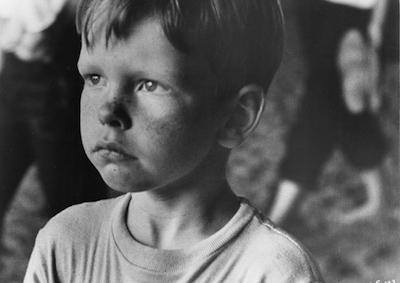Little Fugitive (1953)
When a cruel prank leads seven-year-old Joey to believe he’s killed his older brother, he runs away to Coney Island, taking refuge in pony rides, cotton candy and carnival games as his remorseful brother Lennie tries to make things right. Filmed with crisp naturalism, Little Fugitive captures the vibrant rhythms of 1950s New York and the trials and triumphs of childhood.
Preserved by the Museum of Modern Art in New York with support from the National Endowment for the Arts, The Film Foundation and the Celeste Bartos Film Preservation Fund. 35mm print struck by Cinema Conservancy, released by Kino Lorber.
35mm, b/w, 75 min. Director: Morris Engel, Ruth Orkin, Ray Ashley. Screenwriter: Morris Engel, Ruth Orkin, Ray Ashley. Cinematographer: Morris Engel. Cast: Richie Andrusco, Richard Brewster, Winnifred Cushing.
In the Street (1948)
Noted photographer Helen Levitt joins hands with painter Janice Loeb and writer James Agee in this extraordinary portrait of Spanish Harlem in 1948. Shot with small 16mm cameras, often hidden from sight to allow a more intimate view, the film offers a moving and lyrical vision of daily life in the streets. A second version of the film was released in 1952 with a score by Arthur Kleiner.
35mm, b/w, 16min. Director/Cinematographer: James Agee, Helen Levitt, Janice Loeb.
The Quiet One (1948)
The greatly underappreciated Sidney Meyers and cinematographer Richard Bagley join Helen Levitt, Janice Loeb and James Agee in this touching early docudrama. The first major American film to feature a black youth as its protagonist, it chronicles the life of a 10-year-old emotionally disturbed boy named Donald Peters and his experience of rehabilitation at Harlem’s Wiltwyck School. Its story is loosely based on the life of young Donald Thompson, who played him: rejected by his loved ones, he tries to overcome his trauma. The film was nominated for an Oscar for Best Story and Screenplay, but when the Academy refused Meyers’ request to have Bagley’s name added to the group of writers, he declined the nomination. It went on to be named the second best film of 1949 by the National Board of Review.
16mm, b/w, 67 min. Director: Sidney Meyers. Screenwriter: James Agee, Helen Levitt, Janice Loeb, Sidney Meyers, Richard Bagley. Cinematographer: Richard Bagley, Helen Levitt. Cast: Donald Thompson, Clarence Cooper, Gary Merrill.






 Mobile Navigation
Mobile Navigation

